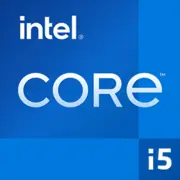Intel Core i5-10505

Intel Core i5-10505: Review and Build Recommendations for 2025
April 2025
Key Specifications: Architecture, Process Technology, and Performance
The Intel Core i5-10505, released in 2020, belongs to the Comet Lake generation and remains a popular choice for budget PCs. Its key parameters include:
- 6 cores / 12 threads — provides multitasking capabilities.
- Base frequency of 3.2 GHz, Turbo Boost up to 4.6 GHz — suitable for light gaming and work tasks.
- 14 nm process technology — outdated technology but with optimized power consumption (TDP of 65W).
- Integrated graphics: UHD Graphics 630 — adequate for basic tasks and 4K video, but a discrete graphics card is required for gaming.
- Geekbench 6 scores: 1532 (Single-Core) / 5235 (Multi-Core) — comparable to the Ryzen 5 3600 but falls short against modern alternatives.
Key Features: Support for Hyper-Threading, Intel Turbo Boost 2.0 technology, hardware acceleration for encryption (AES-NI).
Compatible Motherboards: Sockets and Chipsets
The processor uses the LGA 1200 socket. Suitable chipsets include:
- H410 / B460 / H470 — budget options without overclocking (e.g., ASUS Prime B460-Plus, ~$80).
- Z490 — supports overclocking and PCIe 3.0 x16 (MSI Z490-A Pro, ~$150).
- 500-series chipsets (e.g., B560) — require a BIOS update to work with Comet Lake.
Advice: For most users, B460 boards are sufficient. If overclocking is desired, choose Z490, but note that the multiplier for the i5-10505 is locked.
Supported Memory: DDR4 and Its Features
The processor works only with DDR4. Limitations depend on the chipset:
- H410 / B460: Maximum frequency of 2933 MHz.
- Z490 / B560: Up to 3200 MHz (with XMP profiles).
Example Configuration: 16 GB (2x8 GB) DDR4-2666 is optimal for office tasks. For gaming, 32 GB DDR4-3200 is better, but overclocking is only possible on Z490/B560.
Important: DDR5 and PCIe 4.0 are not supported.
Power Supply Recommendations
With a TDP of 65W and using a discrete graphics card:
- Integrated graphics: A PSU of 300–400W (e.g., be quiet! Pure Power 11 400W, ~$60).
- Graphics card level NVIDIA RTX 3060 / AMD RX 6600: A PSU of 500–600W (e.g., Corsair CX650M, ~$80).
Advice: Do not skimp on the PSU. For systems with RTX 4070 and above, a minimum of 750W is required, but the i5-10505 can be a "bottleneck."
Pros and Cons of the Processor
Pros:
- Low price (~$120 in 2025).
- Energy efficiency (suitable for compact builds).
- Good multi-threaded performance for rendering and streaming.
Cons:
- Outdated 14 nm process technology.
- No support for PCIe 4.0 or DDR5.
- Integrated graphics are weak for modern gaming.
Usage Scenarios
1. Office Tasks and Multimedia:
- Working with documents, browsing, 4K video.
- Example build: i5-10505 + 16 GB DDR4 + 512 GB SSD.
2. Light Gaming:
- Games at Full HD on medium settings with a graphics card (GTX 1660 Super or similar).
3. Home Server or Media Center:
- Low power consumption and support for virtualization.
Limitations: Not suitable for 3D modeling in Blender or 4K gaming.
Comparison with Competitors
- AMD Ryzen 5 5600G (~$180):
- 6 cores / 12 threads, 7 nm process technology, Vega 7 graphics.
- Better in multitasking and gaming without a discrete card.
- Intel Core i5-11400 (~$150):
- Newer Rocket Lake architecture, PCIe 4.0.
- Higher performance in single-threaded tasks.
Conclusion: The i5-10505 only wins in price. For performance, consider the Ryzen 5 5600G.
Practical Assembly Tips
1. Motherboard: Choose B460 for savings or B560 for upgrades.
2. Cooling: Stock cooler is sufficient, but for reduced noise — Arctic Freezer 34 (~$35).
3. Storage: Ensure an NVMe SSD (e.g., Kingston NV2 1TB, ~$50).
4. Graphics Card: For gaming — RTX 3060 or RX 6600 (~$250–$300).
Example Budget Build (~$500):
- CPU: i5-10505 ($120)
- Motherboard: ASRock B460M-HDV ($75)
- Memory: 16 GB DDR4-2666 ($45)
- Storage: 512 GB SSD ($40)
- PSU: EVGA 500W ($55)
- Case: Deepcool MATREXX 30 ($35)
Final Conclusion: Who is the i5-10505 Suitable For?
This processor is a choice for:
- Budget Users: Building a PC for $500–$600.
- Office Systems: Reliability and low power consumption.
- Upgrading Older PCs: Replacing 8th/9th generation processors without motherboard changes.
Why Not to Choose in 2025: If support for DDR5, PCIe 4.0, or high gaming performance is required — better consider the Ryzen 5 7600 or Intel Core i5-13400.
Conclusion
The Intel Core i5-10505 remains relevant for specific tasks, but against modern processors, it appears outdated. Its main advantages are price and energy efficiency. If the budget is tight and PC requirements are minimal — this is your option. For future upgrades, it’s better to choose a platform that supports DDR5 and PCIe 4.0.
Basic
CPU Specifications
Memory Specifications
GPU Specifications
Miscellaneous
Benchmarks
Compared to Other CPU
Share in social media
Or Link To Us
<a href="https://cputronic.com/cpu/intel-core-i5-10505" target="_blank">Intel Core i5-10505</a>